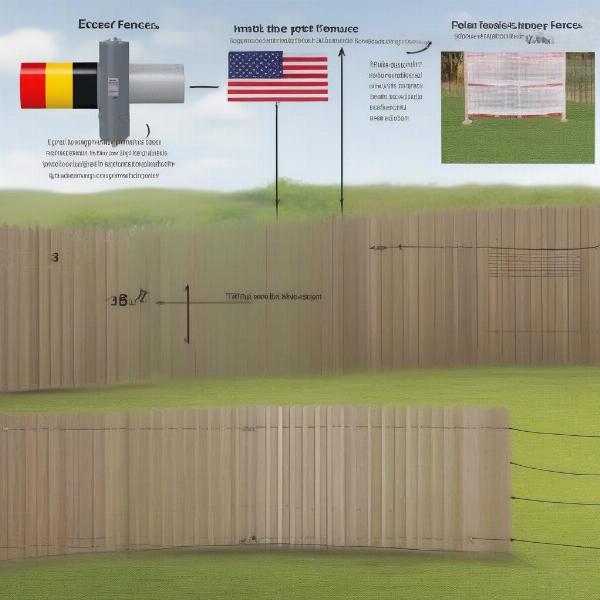Choosing the right fence for your small dog is crucial for their safety and your peace of mind. Whether you have a tiny Chihuahua or a sprightly Jack Russell, a well-chosen pet fence can provide a secure environment for them to play and explore without the risk of escaping. This guide will cover various types of pet fences suitable for small dogs, factors to consider when selecting one, and tips for installation and training.
Factors to Consider When Choosing a Pet Fence for Small Dogs
Several factors influence the best pet fence choice for your small dog. Consider your dog’s breed, temperament, and the layout of your yard. Some breeds are notorious escape artists, requiring a more secure fence than others.
- Height: The height of the fence is paramount. While a small dog might seem easily contained, a surprisingly low fence can be scaled by a determined pup. Ensure the fence is tall enough to prevent jumping or climbing.
- Material: The fence material matters. Wooden fences can be appealing but offer opportunities for chewing and digging. Vinyl or metal fences are more durable and less prone to damage from enthusiastic paws.
- Visibility: Some dogs feel more secure with a visible boundary, while others may be less likely to challenge a solid fence. Consider your dog’s personality and choose a fence that provides the appropriate level of visual containment.
- Underground or Wireless Fences: These systems use buried wires or radio signals to create an invisible boundary. While convenient, they require careful training and may not be suitable for all dogs.
Types of Pet Fences for Small Dogs
There are several types of pet fences suitable for small dogs, each with its own advantages and disadvantages.
Traditional Fences
Traditional fences, like wooden, vinyl, or metal, offer a physical barrier that is easily understood by dogs. They provide a clear boundary and can be customized to suit your aesthetic preferences.
Electric Fences
electric pet fence for small dogs can be effective in deterring escapes, but they require careful training and monitoring. These systems use a mild electric shock to discourage dogs from crossing the boundary.
Invisible Fences
invisible pet fence for small dogs are a popular choice for their discreet appearance. They use buried wires to create an invisible boundary that delivers a static correction when the dog approaches.
 Types of Pet Fences for Small Dogs
Types of Pet Fences for Small Dogs
Installing and Training Your Small Dog with a New Fence
Once you’ve chosen the right fence, proper installation and training are essential. Ensure the fence is securely installed and free of any gaps or weaknesses that your small dog could exploit.
- Introduce the Fence Gradually: Let your dog explore the perimeter of the fence on a leash, rewarding them for staying within the boundaries.
- Positive Reinforcement: Use positive reinforcement techniques, such as treats and praise, to encourage your dog to respect the fence line.
- Consistency: Be consistent with your training and boundary enforcement to ensure your dog understands the rules.
Choosing the Right Pet Fence Size for Small Dogs
While the height of the fence is crucial, consider the overall size and layout of the contained area. Ensure the space provides enough room for your small dog to exercise and play comfortably. A cramped space can lead to frustration and behavioral issues.
Do Foxes Kill Dogs?
While considering outdoor safety for your small dog, it’s natural to think about potential wildlife threats. do foxes kill dogs? While foxes can pose a threat to very small dogs, a secure fence will generally deter them.
Conclusion
Choosing the right pet fence for your small dog is a crucial decision that impacts their safety and well-being. By considering your dog’s individual needs and the various fence options available, you can create a secure and stimulating environment where your furry friend can thrive. Remember to invest in proper training and reinforcement to ensure your dog understands and respects the boundaries of their new space. A well-chosen pet fence provides peace of mind, knowing your small dog is safe and happy within their designated area.
FAQ
- What is the best type of fence for a small dog that likes to dig?: A solid fence material like vinyl or metal sunk a few inches into the ground can deter digging.
- How high should a fence be for a small dog?: The height depends on the breed and jumping ability, but at least 3-4 feet is generally recommended.
- Are invisible fences safe for small dogs?: They can be safe with proper training and monitoring, but not all dogs respond well to them.
- Can I use a chain link fence for a small dog?: Chain link can work, but ensure the gaps are small enough to prevent squeezing through.
- How do I train my small dog to stay within the fence boundaries?: Positive reinforcement and consistent training are key.
- What are the benefits of a pet fence for small dogs?: Safety, containment, peace of mind, and a designated play area.
- How do I choose the right size pet fence for my small dog?: Consider their breed, energy level, and the available space in your yard.
Related Articles
ILM Dog is a leading online resource for dog owners worldwide, providing expert advice on dog breeds, health, training, nutrition, grooming, and more. We’re committed to helping you provide the best possible care for your canine companion. Whether you’re a seasoned dog owner or just starting your journey, ILM Dog offers a wealth of information to support you every step of the way. Contact us at [email protected] or +44 20-3965-8624 for personalized guidance.